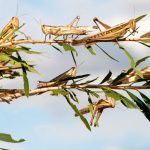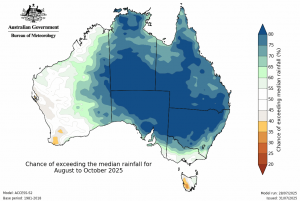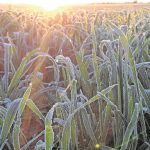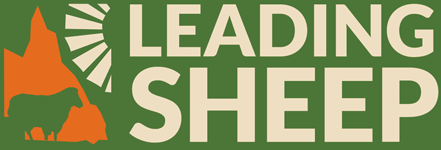- Quick picks: Needle stick injuries, locust watch & BOM spotlight
- Upcoming Leading Sheep events
- Surveys
- Deep dive: Frost – a hidden threat to sheep nutrition
- Upcoming events
- Podcasts and eBulletins
Quick picks:
Needle stick injuries:  Did you know 80% of livestock farmers have experienced a needlestick injury at some point in their lives? These injuries, while unintentional, are usually preventable. Improving vaccination technique, restraining animals appropriately and disposing of needles correctly are easy ways to reduce the risk of needlestick injuries. For more information check out the Farmer Needlestick Injury Brochure
Did you know 80% of livestock farmers have experienced a needlestick injury at some point in their lives? These injuries, while unintentional, are usually preventable. Improving vaccination technique, restraining animals appropriately and disposing of needles correctly are easy ways to reduce the risk of needlestick injuries. For more information check out the Farmer Needlestick Injury Brochure
Managing locusts: a guide for producers in Queensland: Recent wet weather has created ideal breeding conditions for locusts across parts of Queensland, raising concerns for graziers and farmers as swarms threaten pastures. While locusts can cause significant damage, effective control is possible through early detection and coordinated management. Landholders are encouraged to monitor their properties regularly, identify locust nymphs early and report any significant activity to authorities. Support and resources are available to help landholders meet their biosecurity obligations and take appropriate action based on their situation, read more here Managing locusts: guide for Queensland producers
Spotlight on BOM forecasting tools:  Have you always wanted to know how to use long-range forecasts to plan for the weeks, months and seasons ahead?
Have you always wanted to know how to use long-range forecasts to plan for the weeks, months and seasons ahead?
BOM has released two short (<3 minutes) practical videos that will show you where to find and how to use various forecasting tools on their website. These videos will help you understand what long-range forecasts can and cannot do, teach you how to interpret rainfall and temperature maps using percentage change and how you can use this information to forward plan. Watch the videos here Using long-range forecasts | The Bureau of Meteorology.
Upcoming Leading Sheep events
- 2 October. (Rescheduled) Leading Sheep Forum, Longreach. Delivered by DPI. Register here.
Surveys
Spare 10 minutes to support your industry
- If you’re involved in the Australian sheep industry, your insights are needed! A national survey is now open to explore how automation and innovation can improve sheep yard operations. The survey aims to boost labour efficiency, reduce human fatigue and assess impacts on animal welfare. By participating, you’ll contribute to vital research that supports more efficient, sustainable and humane farming practices. Get involved by participating in the survey here Automation and Innovation: National Survey.
- The Wild Dog Action Plan is also seeking input from landholders impacted by wild dogs to assist in evaluating the Action Plan Share your insights on impacts and management here National Wild Dog Action Plan Survey.
Deep dive: Frost – a hidden threat to sheep nutrition
When thinking about what impacts the nutritional quality of pastures, many would typically think drought, insect infestations and floods but have you underestimated frost? It’s equally unpredictable and research has shown that frost can cause a quicker drop in pasture nutritional quality compared to that of other environmental stressors.
Impact of frost on diet quality
At Queensland’s Department of Primary Industries (DPI) Spyglass Research Facility near Charters Towers, pasture quality is routinely monitored through faecal Near-Infrared Spectroscopy (NIRS), providing estimates of crude protein, digestibility and energy in the diet of cattle. After a series of frosts in mid-July 2024, the nutritional value of pastures at the facility dropped sharply. While pasture quality typically declines steadily throughout the dry season, frost rapidly- stripped away the limited nutrients still available in the dry season grass.
“The frost hit all pastures on Spyglass Research Facility. Although pasture quality was already in seasonal decline, the nutritional value it had managed to hold onto, was lost overnight,” explained DPI senior extension officer Karl McKellar.
This sudden drop in pasture quality poses a particular challenge for sheep, especially lactating ewes, weaners and growing lambs, all of which require higher nutritional demands.
What does frost do to tropical pasture?
 In simple terms, when frost occurs, the water surrounding plant cells also freezes. Heavy frosts, repeated frosts or slow thawing will cause the membranes within the plant cells to break and release the important sugars and proteins that contribute to the nutritional value of the pasture. The damage caused by frosts to the cell structure cannot be undone or repaired. Only the growth of new cells and production of new leaves stimulated by rain and warmer temperatures will improve grazing nutritional value.
In simple terms, when frost occurs, the water surrounding plant cells also freezes. Heavy frosts, repeated frosts or slow thawing will cause the membranes within the plant cells to break and release the important sugars and proteins that contribute to the nutritional value of the pasture. The damage caused by frosts to the cell structure cannot be undone or repaired. Only the growth of new cells and production of new leaves stimulated by rain and warmer temperatures will improve grazing nutritional value.
Feeding supplements, will that help?
Feeding a protein supplement such as urea, grain or a plant-based meal high in protein, stimulates the microbes in the rumen. More microbes digesting the feed means the physical rate of passage through the digestive tract is faster. A faster rate of passage encourages sheep to eat more while also increasing the flow of microbes to the abomasum (the true stomach), providing the animal with what is known as microbial protein.
Urea isn’t a silver bullet
When the plant cells break, they don’t just lose protein, they also lose most of the energy, inorganic salts and other nutrients and the pasture becomes less digestible due to increasing fibre. For this reason, providing sheep with a urea supplement that is low or absent in energy and other nutrients, will not necessarily provide all that the sheep are needing to improve productivity.
It rained! Hallelujah, right?
Not quite…nutrition may drop further before the pasture responds with new growth.
If you receive significant rainfall, and it is still cold (e.g. late winter), and there are temperate species in your pasture, such as clovers or rye grass, diet quality may not drop as dramatically as it would if there were only tropical grasses which do not respond or are very slow to respond in cold conditions.
If you receive significant rainfall and minimum temperatures are above 13°C, sub-tropical and tropical plants will develop new leaves from growth points. Although the fresh leaves will be of high nutritional quality, growth will be slow until temperatures increase. Due to the limited availability of these fresh shoots, it is likely that the sheep will still need some form of protein and possibly energy supplementation, until abundant growth occurs.
The takeaway
Frost is a serious but often overlooked factor that can rapidly reduce pasture quality and impact your sheep’s health and productivity. Monitoring pasture condition can allow you to make timely informed decisions about your flock’s performance and your bottom line.
This article was adapted from FutureBeef ‘The impact of frost on diet quality’.
Upcoming events
- 9, 10 & 11 September. SWQ Veg, Fire, Renewables and Mapping – Augathella, Cunnamulla & Charleville. Delivered by AgForce. Event information here.
- 15-19 September. Beyond the border: Goat supply chain tour. Delivered by SQ NNSW Innovation Hub & DPI. Event flyer here.
- 17-18 September. Carbon Edge, Roma. Delivered by ConnectAg. Event information here.
- 3 October. GroWQ Future Grass Growers Forum, Longreach. Delivered by GroWQ. Event information here.
- 4-6 November. Calf Alive 2025 Conference, Longreach. Event information here.
Podcasts and eBulletins
- Around the Camp Leading Sheep podcast
- AuctionsPlus Sheep Results and Catalogue
- AWI Beyond the Bale magazine
- AWI The Yarn podcast
- AWI Weekly Wool Market Report
- Farm Biosecurity News
- MLA Prices and Markets
- Sheep Producers Australia News
- Wool Producers Australia News
